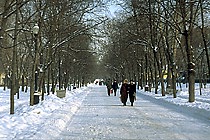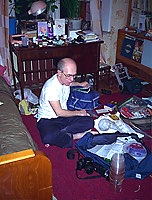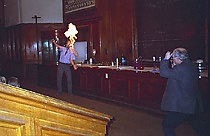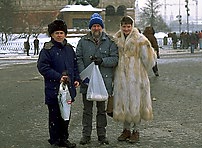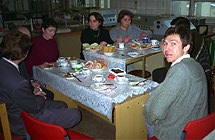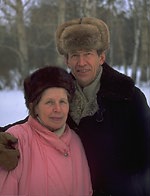Go to Chapter 3The day began with a breakfast consisting of two calabasa (boiled hot dogs served without buns), boiled canned peas, bread, jelly, cheese and coffee. Russians start their day with a hearty albeit unusual breakfast. On another day, Leah prepared an egg quiche-like dish with sausage on top, delicious bread served with wild strawberry and cherry jelly from Tartarya, peroga (like small Runza sandwiches filled with diced eggs and either sausage, or cabbage.) They are very tasty.
After just a few days here, it has become clear that Leah is a most remarkable woman. While we are away, she prepares the next elaborate meal, prints our new e-Poshta (her word for e-Mail) messages and works on her own projects, including her most recent article she plans to submit to a Russian metallurgical journal. Not bad for 84 years old!

Our first week in Russia was spent in Moscow. We spent Monday at the Moscow Pedagogical State University, (MPSU) Department of Chemistry. This institution trains high school teachers. Because we did not have access to a car, we had to pull our two large suitcases and one large duffel bag (which contained the materials for our chemistry demonstration program) through the streets and on the subway. A fresh snow made the 45-minute trip tedious. The subway was very crowded. We got to MPSU with 90 minutes to get ready for the program. Two Russian students helped us. The official party consisted of Ed Carberry and me, Noelle Beyer (a student from SSU) who worked with organizing the demos as we went along and Mikhail Goldfeld who interpreted. The audience consisted of 80 individuals, most of whom were chemistry students (all planning to become teachers) and the faculty. Over 90% of the students were women for several reasons. Teaching at the high school level in Russia traditionally has been an occupation for women. The salaries are so low that men are not drawn into teaching.
Our program lasted 90 minutes and was very well received. We did 33 demonstrations in this short time. Most of the demos were new to the students although they knew what the reactions would produce each time -- very impressive chemistry students! The students reacted in most instances as American students would react, clapping, laughing, etc. At the beginning of the program we handed out wallet/purse-sized periodic tables printed on laminated thermochromic paper. After the program, many of the students came up and wanted us to sign the periodic tables. I wasn't expecting that!
We were given very little time to clean up before we were whisked away for "tea" with the faculty and dean of the department. Tea consisted of cheese and meat sandwiches, chocolates, coffee, tea, and roll-up cakes. After that we were able to use a car to take our bags over to the Mendeleev Institute of Chemistry for use on Tuesday. Then we went to dinner followed by another "tea" and dessert.
Walking back to Goldfeld's apartment after tea, we stopped to look inside a "modern" supermarket. This one was like a convenience store/liquor store combination. All of the prices are in dollars but shoppers must pay in rubles. Visa and Mastercard are also accepted although typical Russians do not have these cards. In fact, ordinary Russians would not normally shop there because the prices were so steep. The prices are given in dollars because they are not subject to inflation. With rubles, they would have to change the prices constantly, although inflation has been under control this past year.
Moscow streets are filled with sidewalk merchants selling western, mostly American, goods. Billboard and TV ads are everywhere -- in English and Russian. It seems that the best way to market a product is to leave the main label in English ("Folger's Coffee," "Marlboro," "Colgate," "Hershey's," etc.) with all of the other information in Russian. The street venders sell beautiful flowers which they display in glass cases. Each case has a half dozen burning candles to keep the flowers above freezing. The glass cases are covered with thick frost because of the water produced from the candles.
Tuesday we were at the Moscow Institute of Chemical Technology named after Dimitri Mendeleev or simply "Mendeleev." Shortly after arrival (and just two hours after breakfast) we had "tea" consisting of tea, coffee, ham sandwiches, cheese sandwiches, chocolates, cookies and a relish sauce. There were a few other items but I forget... The tea was served in the lab and the temperature was about 60 oF. Rooms are typically cold.
The program at "Mendeleev" also went well. There are three frustrations associated with each program: (1) the lecture hall is in use right up until the time we need to be ready; (2) they are out of many chemicals and the ones they do have are often old and ineffective and (3) they have a knack for asking us to come and meet some important person(s) just prior to the program and it would be unthinkable to decline. Our audience at Mendeleev was invited high school chemistry teachers from Moscow and the area. Students and faculty from Mendeleev also attended. All went well despite the odd crisis or two. The audience clapped after many of the demos. Afterwards we signed autographs on periodic tables for 30 minutes!
After the program Ed, Noelle and I went to McDonalds (many in Moscow now) for dinner. I had a Big Mac, fries and a chocolate shake and the bill came to 18,200 rubles. I nonchalantly handed the clerk a 100,000 ruble bill and she gave me 81,800 rubles in change. Somehow the meal tasted extra pricey although it actually cost about $3.64. Upon returning to Leah's apartment, we found that we were just in time for dinner: roast pork and potatoes and many other tasty items. Ooooops! All I could do was to get hungry fast! At all of these dinners it is common to make toasts. Sooner or later, everyone at the table makes some sort of toast and all clink glasses together and take a sip of whatever -- usually wine or brandy.
Most of the time we get around Moscow via the subway system (called the "Metro") which is very good and easy to use. Rides cost 30 cents. Sometimes the trains are crowded. Most men and women wear fur hats and many women wear fur coats.
My blue Creighton stocking cap with the pom pon stands out! Many people read books on the Metro. The books are mostly hardbound and some people have book covers made from newspapers protecting their books. No one speaks on the Metro or in the subway stations. Except for the train's noise, we ride in complete silence. Very few people smile or look happy.
Wednesday's program was at Moscow State University. This university is located in and around one of seven Stalin-era "sky-scrapers." Stalin lamented the fact that Moscow had no sky-scrapers and ordered these seven (very similar) buildings constructed. Soviet sky-scraper technology in the 1930s was inadequate and they learned a lot as they went -- at the expense of many lives. At Moscow State there were about 80 - 100 chemistry teachers in the audience. We did the program in a most fantastic lecture hall with over 500 chairs. The gallery was extremely steep. We may have used the last 30 mL of acetone at this prestigious institution -- setting it on fire with the "Lazy Susan/Screen" demo... (I thought I heard the rector gasp!)
Wednesday night we went to the Boishoi Theater to see "The Nutcracker." It was fantastic although we sat in the 6th balcony. Fortunately we were able to move to chairs along the railing. Tickets were an astronomical $8 for one of the world's most famous theaters! (As an interesting aside, "Boishoi" means 'big.')
On Friday we rested -- well at least we didn't have a program! Instead, we went to Sergei Possad (possad means "town") which has a very famous monastery, Lavre (the center of the Russian Orthodox Church.) Sergei Possad was named Zegorsk for 70 years in honor of a famous revolutionary. After the collapse of the Soviet system, the town, like hundreds of others, reverted back to its historical name. Lavre and the monastery is an ancient walled city begun in the 14th century. Lavre has numerous beautiful cathedrals including one with several beautiful blue onion-shaped copulas. The tour guide opened the museum just for us, and we got special permission to go inside the most beautiful cathedral. There was no heat in the cathedral (it was intended for summer use only) and it was below zero out so we got cold! We learned a great deal about Russian iconosis. A wall of perhaps 50 icons, all of painted wood divided the cathedral into two parts of unequal size. In the smaller part, priests say mass while the worshipers remain on the larger side. Despite the fact that there was no heat, workers were busy with restoration efforts.
Our tour guide to Lavre was Leahna from the "Mendeleev." She is a lecturer on organic chemistry in English and wanted to improve her English language skills. She was much fun. We will give her a hardbound English dictionary. Russians love books and she talked of the availability of books now that the Soviet era is over. (She does regret that the changes had to take place so quickly -- her day-to-day existence in Soviet times was comparatively easy. She did not have to worry about work and a salary and education. All was provided. As a mother of an 8-year old, she worries constantly about her future and the future of Russia.
Later today we leave for a week in Perm where we are doing three programs. Perm is a city 800 miles to the east, near the Ural Mountains. The train trip will take 25 hours.
One final note: Just when I thought Hustis could speak English (I thought I heard him "purr"), I learned that he was actually saying "moordchloscka." How embarrassing!
Da-svee-dan-ya.
Back to the Table of Contents
